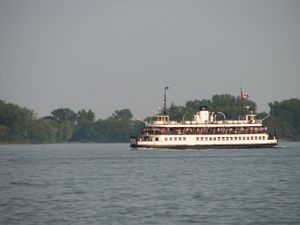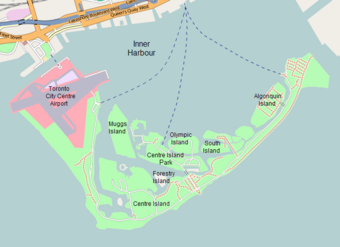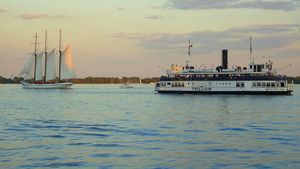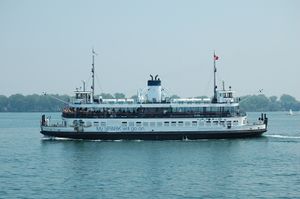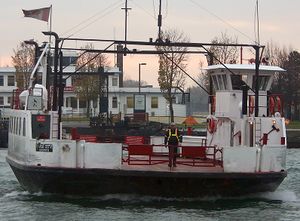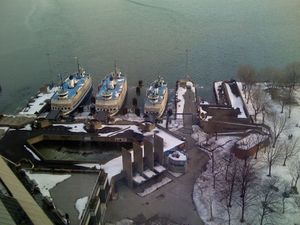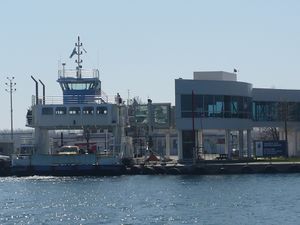Toronto Island ferry services
The Toronto Islands lie in Lake Ontario, just offshore from the Canadian city of Toronto. They are connected to the mainland by the Toronto Island Ferry Services, which provide access to the islands for recreational visitors, access to the mainland for island residents, and access to Billy Bishop Toronto City Airport, which is located at the western end of the island chain.
Services
Currently there are four public ferry services to the islands. Three of these ferry services are operated by the Parks, Forestry and Recreation Division of the City of Toronto, and provide links for passengers and service vehicles from a dock at the foot of Bay Street on the central Toronto waterfront to docks at Hanlan's Point, Centre Island Park and Ward's Island on the Toronto Islands. Service frequencies vary by time of year, with a two round trips an hour on each route in summer, but fewer sailings on fewer routes in winter.[1]
The fourth public ferry service is operated by the Toronto Port Authority and provides a vehicle and passenger connection from a dock at the foot of Bathurst Street to the island airport. The ferry makes the round trip across the 121 metres (397 ft) channel every 15 minutes during airport operating hours. There is no public access between the airport and the rest of the island chain.[2]
Beside the public ferry services, several yacht clubs and marinas located on the islands provide private ferry services for their members and guests.[3][4][5]
History
The first ferry to cross Toronto Harbour to what are now the Toronto Islands was in 1833, using a boat called Sir John of the Peninsular and operated by Michael O'Connor. At the time, the "islands" were in fact still a peninsula, connected to the mainland at their eastern end. Other ferries soon followed, including both the Toronto, a steamboat, and the Peninsular Packet, which was propelled by paddle wheels driven by a horse. A storm in 1858 split the islands from the mainland, and increased the need for ferries.[6]
Throughout the rest of the 19th century ferries proliferated, with most being paddle steamers operated by individual owners. Eventually two competing ferry companies came into being, the Turner Ferry Company and A.J. Tymon's Island Ferry Company. The assets of the Turner Ferry Company were subsequently bought by the John Doty Engine & Ferry Company, which in turn merged with A.J. Tymon's Island Ferry Company in 1892 to form the Toronto Ferry Company.[6][7]
In 1906 and 1910, the Toronto Ferry Company built two sister ships, both being double-decked double-ended paddle steamers, with a capacity of 1450 passengers. They were named Bluebell and Trillium. They were retired in 1955 and 1957 respectively, but Trillium survived and re-entered service in 1976. She is still in service and is operated by the Great Lakes Schooner Company for Corporate functions and Private Functions, as well as ferry runs throughout the summer. She is now 100 years old. [8][9][10]
The Toronto Ferry Company continued to operate the ferry services until 1926, when their services and fleet was purchased by the City of Toronto and transferred to the Toronto Transportation Commission (TTC, later renamed the Toronto Transit Commission), the body that operates the city's transit system. The three double ended, diesel engined and screw driven ferries that form the backbone of today's service to the islands were all built for the TTC, these being the William Inglis in 1935, the Sam McBride in 1939, and the Thomas Rennie in 1951.[11]
In 1938 the Toronto Harbour Commission commenced operating a ferry service to the new Toronto Island Airport, then under construction. A scow was adapted for use as a cable ferry, with the intention that this ferry would operate for a five year period. However the scow remained in service for twenty-five years before being replaced by the ferry Maple City. The backup ferry Windmill Point was acquired in 1985 and a new replacement ferry, TCCA1, in 2006.[12]
In 1961 the ferry services operated by the TTC were transferred to Metro Toronto Parks and Culture, a department of the then Municipality of Metropolitan Toronto. In 1997 the metropolitan municipality was merged with its member municipalities, becoming the enlarged City of Toronto, and the park ferry services became the responsibility of city's Department of Parks and Recreation. In 2005 responsibility for these services was transferred to the city's Parks, Forestry and Recreation Division, where it remains. The airport ferry remains the responsibility of the TPA.
Ferry fleet
| Vessel | Operator† | Acquired | Retired | Notes |
| Luella | TuF/TFC/TTC | 1880 | 1934 | Single deck single ended paddle steamer, with a capacity of 122 passengers. Built by W. Armour & Company and John Doty Engine Company. Accidentally scrapped 1934 |
| Mayflower | JDE/TFC/TTC | 1890 | 1938 | Double deck double ended paddle steamer, with a capacity of 900-1000 passengers. Built by Bathurst Street Wharf. After retirement converted into a barge. Sister ship to Primrose. |
| Primrose | JDE/TFC/TTC | 1890 | 1938 | Double deck double ended paddle steamer, with a capacity of 900-1000 passengers. Sister ship to the Mayflower. Built by Bathurst Street Wharf. After retirement converted into a barge. Sister ship of Mayflower |
| Ned Hanlan | TFC/TTC/MPR | 1902 | 1966 | Built by Toronto Dry Dock Company in 1932. Harbour tug used to provide winter ferry service for island residents. Named for local rowing legend Ned Hanlan. Now displayed at Stanley Barracks at the CNE. |
| Bluebell | TFC/TTC | 1906 | 1955 | Double deck double ended paddle steamer, with a capacity of 1450 passengers. Built by Polson Iron Works Limited. Retired 1955 and stripped down and stored next to Island Water Filtration Plant in 1976, hull used as breakwall at Tommy Thompson Park near the Eastern Gap. Sister ship of Trillium |
| Trillium | TFC/TTC/MPC/TPR | 1910 | - | Double deck double ended paddle steamer. Sister ship to the Bluebell. Built by Polson Iron Works Limited. Retired in 1957 and used by Metro Toronto Works Department as a garbage scow (barge), but re-entered service in 1976 after being refurbished. Original passenger capacity of 1450 reduced to 955.[8] Sister ship of Bluebell |
| Miss York | TFC/TTC | 1918 | 1929 | Burned 1929? |
| Miss Simcoe | TFC/TTC | 1918 | 1929 | Named for the Simcoe (Elizabeth Simcoe?) Burned 1929 |
| Clark Bros. | TFC/TTC | 1890 | 1927 | Named for Tom (T.J.) Clark; burned in 1930 at Sunnyside Park[14] |
| John Hanlan | TFC/TTC | 1918 | 1927 | Built by Abbey, of Port Dalhousie and named for John Hanlan, father of Ned Hanlan and Toronto Island hotel keeper; burned 1929 |
| T.J. Clark | TFC/TTC/MPR | 1911 | 1930 | Wooden screw ferry with engines by Polson Iron Works and built by Clark Limited. Named for Tom (T. J.) Clark, co-operator of wooden screw ferry that began service in 1890.[15]. Operator as ferry from 1911 to 1927; sold to City of Toronto and operator by the TTC. Decommissioned 1959 and sold to Toronto Drydock Company Ltd, scrapped by 1961 |
| Alymer | TFC/TTC | 1918 | 1929 | - |
| Buttercup | TFC/TTC | 1918 | 1929 | - |
| Jasmine | TFC/TTC | 1918 | 1929 | Renamed Ojiboway. Burned 1929 |
| William Inglis | TTC/MPC/TPR | 1935 | - | Double deck double ended diesel screw passenger ferry, with a passenger capacity of 400. Built by Toronto Drydock Company.[16] Named after William Inglis, head of local appliance manufacturer John Inglis and Sons.[17] |
| Sam McBride | TTC/MPC/TPR | 1939 | - | Double deck double ended diesel screw passenger ferry, with a passenger capacity of 1000. Built by Toronto Drydock Company. Named after former Toronto Mayor and alderman Sam McBride.[11][18] |
| Thomas Rennie | TTC/MPC/TPR | 1951 | - | Double deck double ended diesel screw passenger ferry, with a passenger capacity of 1000. Built by Toronto Drydock Company. Named after former Toronto Harbour Commissioner Thomas Rennie.[11][19] |
| Ongiara | TTC/MPC/TPR | 1960 | - | Single deck double ended diesel screw vehicle and passenger ferry. Capacity of 220 passengers, 10 cars or 8 trucks. Used to provide winter service and to carry service vehicles. Built by Russel Bros., Owen Sound, Ontario. Repowered in November 2006. [20] |
| Maple City | TPA | 1964 | - | Single deck double ended diesel vehicle and passenger ferry. Capacity of 40 passengers and 6 cars. Operates to the island airport.[21] |
| Windmill Point | TPA | 1985 | - | Single deck double ended diesel passenger ferry, with a capacity of 207 passengers. Operates to the island airport.[22] |
| TCCA1 | TPA | 2006 | - | Double deck double ended diesel vehicle and passenger ferry. Operates to the island airport. Built by Hike Metal Products of Weatley, Ontario. Name is an acronym of Toronto City Centre Airport 1.[23] |
†Operators: JDE=John Doty Engine & Ferry Company;
MPC=Metro Toronto Parks and Culture; TFC=Toronto Ferry Company;
TPA=Toronto Port Authority;
TPR=City of Toronto Parks and Recreation;
TTC=Toronto Transportation/Transit Commission;
TuF=Turner Ferry Company
Docks
With the exception of the Bay Street docks, all other docks are not enclosed and consist of a series of metal fences and ramps.
City or Bay Street Docks: This dock is located at the foot of Bay Street on the mainland and consists of four piers. They are located in the enclosed main docks, and the last pier is an open area to the east for the larger Trillium ferry boat. Toronto Fire Services fireboat William Lyon Mackenzie shares the dock spaces. During winter months the ferries (other than Trillium) are stored here with upper decks covered with a tarp. Trillium is stored at nearby Yonge Street Slip.
Hanlan's Point Docks: This dock is located to the west next to the island airport and consists of three piers.
Centre Island Docks: This dock is located on Island Park and consists of two piers. There are washrooms and a snack bar nearby. There is no winter service from this dock. Newly covered area was added to provide additional shelter space.
Ward's Island Docks: This dock is located on Ward's Island to the east and consists of a single pier.
Western Gap: This dock is located at the foot of Bathurst Street and consists of a single pier. Parking is available for cars not crossing over to the Island on the ferry.
Island Airport Docks: This dock is located at the north end of the island airport and consists of a single pier/loading ramp.
See also
References
Specific
- ↑ "Toronto Island Park". City of Toronto. http://www.toronto.ca/parks/island/. Retrieved 2008-03-13.
- ↑ "Toronto City Centre Airport Facts". Toronto Port Authority. http://www.torontoport.com/airport_facts.asp. Retrieved 2008-03-13.
- ↑ "tender and schedules". Queen City Yacht Club. http://www.qcyc.ca/club/tender.html. Retrieved 2008-03-18.
- ↑ "Launch Schedule". Royal Canadian Yacht Club. http://www.rcyc.ca/AboutRCYC/LaunchSchedule/tabid/82/Default.aspx. Retrieved 2008-03-18.
- ↑ "Water Tender Schedule". Toronto Island Marina. http://torontoislandmarina.com/tender_service.html. Retrieved 2008-03-18.
- ↑ 6.0 6.1 Partridge, Larry (1976-03). "Toronto Island Ferry History: the Beginning". http://www.angelfire.com/ca/TORONTO/history/islandbegin.html. Retrieved 2003-03-14.
- ↑ "Prominent Men of the Great Lakes - Capt. Andrew J. Tymon". The Globe, Toronto. 1898-01-01. http://www.hhpl.on.ca/GreatLakes/Documents/ProminentMen/default.asp?ID=c064. Retrieved 2008-03-14.
- ↑ 8.0 8.1 "Trillium". Canadian Transportation Agency. 2006-03-08. http://forms.cta-otc.gc.ca/CVIS/Ship_e.cfm?ShipID=126833. Retrieved 2008-03-18.
- ↑ "Hail to the Trillium". Scanner (Toronto Marine Historical Society). Summer 1976. http://www.hhpl.on.ca/GreatLakes/Documents/Scanner/08/09/default.asp?ID=c004. Retrieved 2008-11-21.
- ↑ "The Elegant Paddle Steamer". The Great Lakes Schooner Company. http://www.greatlakesschooner.com/toronto-cruise-ship-trillium.html. Retrieved 2008-11-21.
- ↑ 11.0 11.1 11.2 Partridge, Larry (1976-03). "Toronto Island Ferry History: The Modern Fleet: 1935 - 1960". http://www.angelfire.com/ca/TORONTO/history/islandmodern.html. Retrieved 2003-03-14.
- ↑ "Toronto City Centre Airport: A History". Toronto Port Authority. http://www.torontoport.com/airport_history.asp. Retrieved 2008-03-14.
- ↑ Partridge, Larry (1976-03). "Toronto Island Ferry History: Fleet List". http://www.angelfire.com/ca/TORONTO/history/islandfleet.html. Retrieved 2003-03-14.
- ↑ [1]
- ↑ [2]
- ↑ "William Inglis". Canadian Transportation Agency. 2006-03-08. http://forms.cta-otc.gc.ca/CVIS/Ship_e.cfm?ShipID=158663. Retrieved 2008-03-18.
- ↑ Filey, Mike (1998). Discover and Explore Toronto's Waterfront. Dundurn Press Ltd.. p. 123. ISBN 1550023047.
- ↑ "Sam McBride". Canadian Transportation Agency. 2006-03-08. http://forms.cta-otc.gc.ca/CVIS/Ship_e.cfm?ShipID=171709. Retrieved 2008-03-18.
- ↑ "Thomas Rennie". Canadian Transportation Agency. 2006-03-08. http://forms.cta-otc.gc.ca/CVIS/Ship_e.cfm?ShipID=193649. Retrieved 2008-03-18.
- ↑ "Ongiara". Canadian Transportation Agency. 2006-03-08. http://forms.cta-otc.gc.ca/CVIS/Ship_e.cfm?ShipID=318766. Retrieved 2008-03-18.
- ↑ "Maple City". Canadian Transportation Agency. 2006-03-08. http://forms.cta-otc.gc.ca/CVIS/Ship_e.cfm?ShipID=176000. Retrieved 2008-03-18.
- ↑ "Windmill Point". Canadian Transportation Agency. 2006-03-08. http://forms.cta-otc.gc.ca/CVIS/Ship_e.cfm?ShipID=198041. Retrieved 2008-03-18.
- ↑ "Improved Access to the TCCA". Toronto Port Authority. 2007-01-12. http://www.torontoport.com/PortAuthority/airport_news_report_content.asp?id=253. Retrieved 2008-03-27.
General
- "The Toronto Islands Then & Now: A guided tour through 200 years of history" (DVD). The Content Shop. August 2006. http://www.toronto-island.com.
- Toronto Island Ferry History: the 1980s - Toronto Island Ferry
- a Glimpse of Toronto's History - Opportunities for Commemoration of Lost Historical Sites City Planning Division, Urban Development Services - City of Toronto 2001, MPLS 076 and MPLS 068
